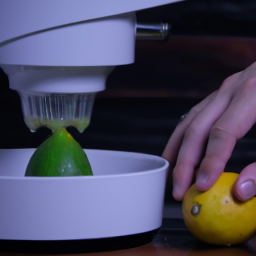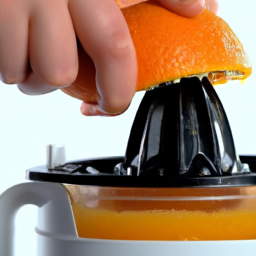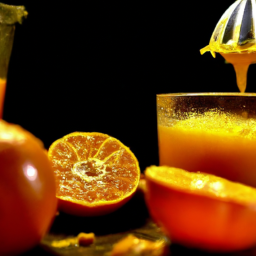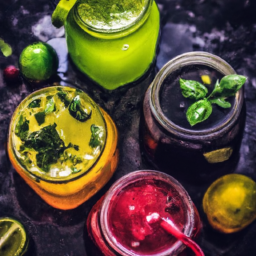I love adding **fresh lime juice** to my drinks and meals, but squeezing it by hand can be challenging. Luckily, **electric juicers** make it much easier. If you want to save time and effort when making your favorite lime recipes, **electric juicers** are the way to go.
In this article, I will be sharing my step-by-step guide on how to juice a lime in an electric juicer.
First and foremost, it’s important to have the right equipment. A high-quality electric juicer will make the process much smoother and more efficient. With the right juicer, you’ll be able to extract the most juice possible from your limes, leaving you with a delicious and refreshing addition to your meals and beverages.
So, let’s dive into the details and learn how to use this handy kitchen gadget to juice a lime in no time!
Key Takeaways
- Using an electric juicer is the easiest and most efficient way to juice limes.
- High-quality electric juicers can extract the most juice possible from limes.
- Rolling limes on a flat surface before cutting them open can release more juice.
- Proper storage techniques are essential for preserving the quality and taste of lime juice.
Select the Right Equipment
Make sure you’ve got the right gear, like an electric juicer, to easily and efficiently juice your lime. Electric juicers are a great investment because they can make short work of juicing citrus fruits, and they’re easy to clean and maintain. They come in different sizes and prices, so choose one that suits your needs and budget.
Before using an electric juicer, make sure it’s clean and in good working condition. Follow the manufacturer’s instructions for cleaning and maintenance. If you don’t have an electric juicer, there are alternative juicing methods such as using a citrus reamer or a hand-held juicer. However, these methods may not be as efficient or as easy to use as an electric juicer.
Once you have your equipment ready, it’s time to choose high-quality limes to get the best flavor and juice extraction.
Choose High-Quality Limes
To get the most flavorful and zesty lime juice, it’s essential to start with fresh and high-quality limes. I highly recommend using organic limes, as they’re free from harmful pesticides and chemicals that can affect the taste of your juice. Organic limes also tend to be juicier and more flavorful compared to their non-organic counterparts.
When selecting your limes, look for ones that are firm and heavy for their size. They should also have a bright green color and feel slightly oily to the touch. To squeeze the most juice out of your limes, roll them firmly on a flat surface before cutting them open. This helps to break down the fibers and release the juice.
With these tips in mind, let’s move on to the next step of washing and prepping the limes for juicing.
Wash and Prep the Limes
First things first, you’ll want to give those limes a good scrub under cold water to remove any dirt or residue. Think of it like giving them a refreshing shower after a long day at the beach. You don’t want any dirt or bacteria ending up in your freshly squeezed lime juice.
Once they are clean, use a sharp knife to cut off the ends of the limes. This will make it easier for the juicer to extract the juice. When it comes to juicing limes, using organic limes is always a good option. Not only are they better for the environment, but they’re also free of harmful pesticides.
If you can’t find organic limes, try to choose limes that are ripe and have a bright green color. Avoid limes that are yellow or have any brown spots. By properly washing and prepping your limes, you’ll ensure that your juice is clean and free of any unwanted particles.
Now that your limes are prepped and ready to go, it’s time to start juicing.
Begin Juicing
Now it’s time for me to get my hands on those juicy limes and start extracting all that delicious citrus goodness.
First, I make sure that my electric juicer is plugged in and ready to use. Then, I cut the limes into halves and place them onto the juicer’s reamer.
I turn on the machine and let it work its magic, making sure to apply gentle pressure to the limes to ensure maximum juice extraction. There are different juicing techniques you can use depending on the type of juicer you have.
With electric juicers, the machine does most of the work for you, but you still need to make sure the limes are properly positioned and you’re applying enough pressure to extract all the juice. Lime juice benefits include being a great source of vitamin C and antioxidants, which can boost your immune system and help protect against disease.
With the juicing process complete, it’s time to move onto the next step and extract the juice from the machine’s container.
Extract the Juice
As the machine works its magic, I can’t help but feel like a master chef creating a delicious concoction. Extracting the juice from the lime is the most satisfying part of the process.
Here are the steps I follow to get the perfect lime juice:
-
Cut the lime in half: Before extracting the juice, I cut the lime in half using a sharp knife. This makes it easier to extract the juice from the lime.
-
Place the lime in the juicer: I place the lime on the juicer’s reamer, making sure that the cut side is facing down.
-
Press the reamer: I press the reamer down onto the lime, and the machine does the rest. Within seconds, the juicer extracts all the juice from the lime, leaving behind the pulp and seeds.
Creative uses of lime juice are endless. Lime juice benefits include being a great source of vitamin C, aiding in digestion, and boosting the immune system. However, before using the juice, it’s important to filter it to remove any unwanted pulp or seeds.
Filter the Juice
Filtering out any unwanted bits from this zesty concoction will ensure a smooth and refreshing finish to your drinks and dishes. To filter the juice, I recommend using a fine mesh strainer or cheesecloth. Simply pour the juice through the strainer or wrap the cheesecloth around the lime pulp and squeeze out the juice. This will remove any pulp or seeds that may have made their way into the juice.
Once you have filtered the juice, you can use it in a variety of ways. Filtered lime juice is great for making cocktails, marinades, salad dressings, and even desserts. The benefits of using filtered juice include a smoother texture and a more consistent flavor. Additionally, using filtered juice can prevent any unwanted bits from ruining the presentation of your dish. Now that you have filtered your juice, it’s time to store it properly to ensure it stays fresh and ready to use.
Store the Juice
I always make sure to store my freshly squeezed lime juice properly so it stays fresh for as long as possible. The best containers for storing lime juice are glass jars or bottles with tight-fitting lids, which help prevent exposure to air and keep the juice from oxidizing.
Lime juice can be stored in the refrigerator for up to a week, but it’s best to use it within the first few days for optimal flavor and quality.
The Best Containers for Storing Lime Juice
When it comes to keeping your lime juice fresh, using the right container can make all the difference. Lime juice preservation is key, and proper storage techniques are essential in achieving this goal.
Here are the best containers for storing lime juice:
-
Glass containers with airtight lids are a great option for storing lime juice. They’re non-reactive, meaning they won’t interact with the juice, and they keep the juice fresh for longer periods. Glass containers are also easy to clean and reuse.
-
Plastic containers with tight-fitting lids are also great for storing lime juice. Look for containers made from food-grade plastic, as these are safe for storing food and won’t leach chemicals into the juice. Plastic containers are also lightweight and easy to transport.
-
Stainless steel containers are another option for storing lime juice. They’re durable and won’t break like glass, and they’re also non-reactive. Stainless steel containers are also easy to clean and won’t retain odors.
-
Mason jars are a classic option for storing lime juice. They’re affordable, widely available, and come in various sizes. Mason jars are also airtight, which helps to keep the juice fresh for longer periods.
When it comes to preserving lime juice, using the right container is essential. But even with the best container, it’s important to know how long lime juice can be stored to ensure that it stays fresh.
How Long Lime Juice Can Be Stored
In my previous section, I discussed the best containers for storing lime juice. Now, let’s talk about how long lime juice can be stored. Lime juice can be stored for up to one week in the refrigerator. However, its quality and taste begin to deteriorate after 2-3 days. Therefore, it’s best to consume it within 2-3 days to get the maximum benefits from it.
Lime juice has many uses and benefits. It’s commonly used in cocktails, marinades, dressings, and sauces. It’s also a great source of vitamin C, which helps boost the immune system and fight off infections. Additionally, lime juice contains antioxidants that help protect the body from damage caused by free radicals. So, incorporating lime juice into your diet can have many health benefits.
To ensure that your lime juice is fresh and nutritious, it’s important to clean the juicer after each use.
Clean the Juicer
To keep your electric juicer in top condition and avoid any buildup of lime residue, it’s important to thoroughly clean it after each use. Effective cleaning and maintenance tips include disassembling the juicer and washing each part separately with warm soapy water. Use a soft brush to scrub away any remaining pulp or debris. Be sure to dry each part thoroughly before reassembling the juicer.
Avoiding common juicing mistakes can also help keep your juicer clean. For example, try to avoid overfilling the juicer with lime wedges, as this can cause the excess juice to overflow and leave behind a sticky mess. Additionally, try to clean your juicer as soon as possible after use to prevent any lime residue from drying and becoming more difficult to remove.
With proper cleaning and maintenance, your electric juicer will continue to produce fresh lime juice for all your culinary needs.
Now that your juicer is clean and ready to use, it’s time to enjoy your freshly squeezed lime juice. Follow the next section for tips on how to make the most of your citrusy creation.
Use Your Fresh Lime Juice
Now that I’ve freshly squeezed lime juice, I’m excited to use it in some recipes!
There are so many dishes that can benefit from the bright, tangy flavor of lime juice.
I’ll also share some tips on how to cook with lime juice to get the most out of its flavor.
Recipes that Use Lime Juice
Hey there, looking to add a zesty kick to your recipes? Lime juice is a versatile ingredient that can be used in a variety of dishes, from cocktails to marinades to salad dressings. Not only does it add a bright, tangy flavor, but lime juice also has some great health benefits. It’s high in vitamin C, an antioxidant that helps boost the immune system, and it can aid in digestion.
If you’re out of fresh limes or just want to switch things up, some substitutes for lime juice include lemons, vinegar, or even white wine.
Here are four recipe ideas that use lime juice as a key ingredient:
- Ceviche: This dish typically consists of raw fish marinated in lime juice, which ‘cooks’the fish without heat. Add in some diced tomatoes, onions, and cilantro for a refreshing appetizer or main dish.
- Margaritas: This classic cocktail is made with tequila, lime juice, and triple sec. Shake it up with ice and serve in a salt-rimmed glass for a fun and festive drink.
- Grilled chicken or fish: Marinade your protein in a mixture of lime juice, olive oil, garlic, and spices for a flavorful and juicy result.
- Avocado toast: Mash up some avocado, add a squeeze of lime juice, and spread it on a slice of toast. Top with salt, pepper, and any other toppings you desire, such as sliced tomato or a fried egg.
Now that you have some recipe ideas, let’s move on to some tips for cooking with lime juice.
Tips for Cooking with Lime Juice
Lively limes lend lovely flavor to your dishes, so let’s learn some tips for cooking with this citrus sensation. Lime juice not only adds a zesty tangy flavor to your meals, but it also provides several health benefits. It’s a great source of vitamin C, which helps boost your immune system and fights against diseases. Additionally, lime juice can aid in digestion, cleanse the liver, and even lower blood sugar levels.
To incorporate lime juice into your meals, there are many creative ways to add this zesty flavor. You can use it as a marinade for meats, add it to salad dressings, use it as a topping for seafood, or even mix it into your morning smoothie. Experimenting with lime juice can also help you discover new flavor combinations that you never knew were possible.
With practice, you can become a master of cooking with lime juice and create delicious, healthy meals that your taste buds will love.
Practice and Experiment
You’ll want to practice and experiment with the amount of pressure you use when juicing a lime in your electric juicer. Here are some tips that can help:
-
Start with a small amount of lime juice and gradually increase the amount as you become more comfortable with the juicing process. This will allow you to get a feel for the pressure needed to extract the juice without overloading your juicer.
-
Experiment with different techniques, such as twisting the lime on the juicer or pressing down with a gentle force. This will help you find the method that works best for you and your juicer.
-
Consider the flavor pairings of the lime juice. Lime pairs well with a variety of flavors, such as cilantro, jalapeno, and garlic. Experiment with these flavors to create unique and delicious dishes.
-
Don’t be afraid to make mistakes. Juicing a lime in an electric juicer takes practice and patience. Keep experimenting until you find the technique that works best for you and your taste buds. With time, you’ll become a pro at juicing limes in no time.
Frequently Asked Questions
Can you use an electric juicer for other citrus fruits besides limes?
Electric juicers are a versatile tool for juicing citrus fruits. Oranges and lemons can be easily juiced using the best electric juicers for juicing citrus fruits. Expand your options and experiment with a variety of citrus fruits.
How long can you store fresh lime juice in the refrigerator?
I store fresh lime juice in an airtight container in the refrigerator. It can last up to 2 weeks if properly stored, but the flavor may start to deteriorate after a few days. It’s best to use it as soon as possible.
Can you juice limes with the skin on?
Juicing limes with the skin on adds a tart, bitter flavor and extra nutrients to your juice. Choose thin-skinned limes with a bright green color and avoid any with blemishes or soft spots.
Can you use bottled lime juice instead of fresh juice in recipes?
I always use fresh lime juice in recipes for its superior taste and nutritional benefits. When shopping, select limes that are firm and heavy for their size. Store in a cool, dry place and juice as needed for optimal flavor.
Can you freeze fresh lime juice for later use?
Freezing fresh lime juice is an excellent way to preserve it for later use. I recommend using an airtight container and labeling it with the date. This will ensure that the lime juice stays fresh and flavorful for up to six months.
Conclusion
Well folks, that’s how you juice a lime in an electric juicer! It may seem like a simple task, but using the right equipment, selecting high-quality limes, and properly prepping and juicing them can make all the difference in the end result.
Juicing limes can be a fun and creative process. It’s like squeezing out a burst of sunshine into your drinks and dishes. And with practice and experimentation, you can learn how to adjust the amount of pulp and acidity to your liking.
So go ahead and give it a try! Your taste buds will thank you for the fresh and zesty flavor.
Ilana has been a vegan for over 10 years. She originally made the switch for health reasons, but soon found herself becoming more and more passionate about the ethical and environmental implications of a vegan lifestyle. Ilana is the author of The Graceful Kitchen, a blog all about veganism. She loves to cook up delicious and nutritious vegan meals, and share her recipes with others who are interested in leading a cruelty-free life. Ilana is also a strong advocate for using whole foods as the foundation of a healthy diet, and believes that going vegan is one of the best ways to achieve this.










